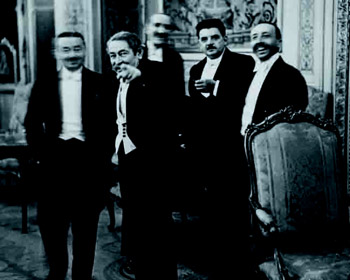Erich Salomon
The King of the Indiscreet,
1928 – 1938
12 November 2008 – 25 January 2009
Hôtel de Sully
62, rue Saint-Antoine
75004 Paris
France
“Ah, there he is, the king of the indiscreet!” exclaimed Aristide Briand as he pointed to Erich Salomon in the salons of the Quai d’Orsay, where he had been caught by surprise. The words would become famous, especially since the French Foreign Minister spoke them just as Salomon had pressed his shutter release. It was August 1931, and for three years now the German photographer had been finding his way into conferences and other international meetings, bringing back surprising photographs of the most prominent political figures. Paradoxically, however, if there was one word that described Salomon’s practice it was discretion.
The king of the indiscreet
Born into a rich Berlin banking family, Erich Salomon studied zoology and architecture and went on to gain a doctorate in law. When the Salomons were ruined by the rampant inflation of the postwar years, he was forced to find work. In 1925, the advertising department at Ullstein Verlag took him on. He began working with photography, and developed special methods for discreetly taking photographs in the law courts. His career as a photojournalist took off in 1928, when his report on the much discussed Krantz trial appeared in the Berliner Illustrirte Zeitung. Salomon specialized in covering major international conferences and political or social events. He took numerous portraits of figures from the worlds of politics, finance and industry, but also from the press, the sciences and the arts.
Famous contemporaries in unguarded moments
Erich Salomon’s group and individual portraits can be viewed as studies of different milieus, forming an inventory of the psychological and behavioural tendencies of people, captured unawares. In this sense, his approach belongs to the German tradition of encyclopaedic investigation. In 1931, Salomon published Famous Contemporaries in Unguarded Moments, by Engelhorn Verlag, Stuttgart, presenting himself as a hunter tracking down the true face of personalities, and detailing the exact circumstances in which the photographs were taken. Taken at just the right moment, his images avoided the frozen expressions of posed photography. This section gives an idea of the range of postures and expressions revealed by his skill with the hidden camera.
Doctor Erich Salomon
If Salomon won respect for his technical expertise, he was also careful to cultivate his renown. He insisted that his signature (“Doctor Erich Salomon”) should appear on every reproduction. A number of articles and interviews related the adventures and secrets of the “formidable doctor.” The press nicknamed him the “master of the hidden camera” and the “Houdini of photography.” But in fact Salomon’s legend also served as a guarantee for his clientele: it ensured the press that it would be provided with sensational images, and his subjects (whom he always treated respectfully) that the images published of them would be sincere but also well-disposed.
The Ilford exhibition, 1937
For his contemporaries, the Salomon method represented a totally new form of photography. His modernity lays in his ability to use every available medium to disseminate his images. In addition to his publications and talks, he had two solo exhibitions in London, the first at the Royal Photographic Society in 1935, and the second at the Ilford Gallery in 1937. Twenty-four of the seventy prints in the 1937 exhibition are included.
With this project, the Jeu de Paume is inaugurating a cycle of three exhibitions at the Hôtel de Sully on the subject of European photography between the wars. The series covers three main areas: German photojournalism, as represented by Erich Salomon, avant-garde photography in Paris from 1920 to 1940, in the Christian Bouqueret collection, and, finally, war photography, through the work of Agustí Centelles during the Spanish Civil War.
Exhibition organized by the Berlinische Galerie, Berlin, and the Jeu de Paume, Paris, with support from Olympus, in partnership with Arte, De l’air, evene.fr, Le Monde 2 et RFI.
Curator: Michaël Houlette


